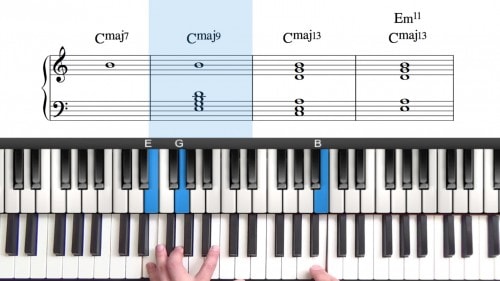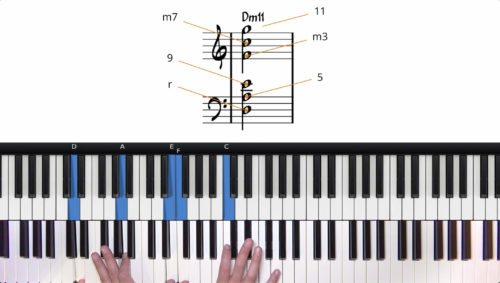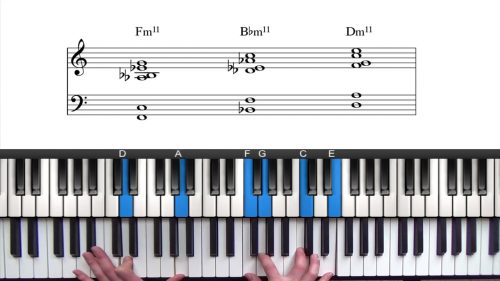Red Garland Voicings Tutorial
In this lesson we are going to create a useful 2 handed voicing, widely known as the Red Garland Voicing.
Red Garland is perhaps most famous for his unique block chord style. He performed and recorded extensively throughout his career, with many of the jazz greats including Miles Davis, Charlie Parker, and, Coleman Hawkins.
The Red Garland voicing has a very distinctive ‘block chord’ sound, but compared to previous styles of block chords, it has a much brighter quality and is slightly more dissonant in places.
The voicing also creates more fullness in the upper register which allows you to produce a very rich and full sound out of his piano. Similar to earlier block chord styles, the Red Garland voicing is often used to harmonise each note of a stepwise melody line.
This is a very nice voicing to comp with and is quite easy to learn because you are just playing a left hand voicing, and then doubling the melody with your right hand with a fifth interval in between.
Sometimes the 5th interval in the middle of you right hand will ‘clash’ with the underlying harmony and this creates some interesting colour and tension.
In this lesson, we will use the tune ‘There Will Never Be Another You’ to apply the red garland voicing. If you haven’t watched that jazz standard tutorial already, I would recommend watching that lesson first to familiarise yourself with the chords and changes.
Practice Tips
Check out the 3 recordings of Red Garland below. He uses the block chord style in all 3 so definitely check out those recordings. Also remember to use the iRealPro app to get the backing track for this tune and set the drum beat on 2+4 which helps when working on swing rhythm.
We will applying these voicings to new jazz standards that we will be working on so spend some time to familiarize your self with this style of playing.







I love the sound of the Red Garland block chords. So happy you produced this lesson.
I’m also working on your 12 bar blues course which is great.
So I just tried playing Red Garland block chords over the F blues and it sounded nice, it will be nice to play the 12 bars a few times with single note improvisation and then once through entirely in Red Garland style and then maybe another time with single note improv. Just one more thing to make it sound more interesting.
Are there any other ways to combine 12 bar blues and Red Garland style? And do you know of any instances of Red playng 12 bar blues?
I wonder why there have been no comments on this lesson which I found so useful…
Many thanks.
Brad
Hi Brad,
Apologies for not replying to this original comment. There was a website bug where I wasn’t notified of all comments and it seems this was one of them. Please excuse the tardiness in my reply!
To answer your question, yes, Red was a master of the blues and has lots of blues recordings. I particularly like the following record – “Your Red Wagon” – because Red uses his signature voicing in the head, and also in the improvised solo:
Also check out his recording of C Jam Blues.
Finally thanks for the comment – I’m glad you found this lesson useful. It’s my favourite comping style and also my favourite style of block chord. It’s lots of fun to play around with.
Cheers,
Hayden
Hi Hayden,
Do you know, did Red Garland also play Shearing style block chords or drop 2 block chords or Barry Harris style block chords? Or when Red played block chords did he stick to the Red Garland style block chords for the most part?
Just wondering, maybe you can get pretty far not mastering the others–the red garland style is so much easier.
Thanks.
BG
Hey Brad,
Interesting question!
Red pioneered his own block chord sound and so this style of block chords was truly his signature. I can’t think of any recordings where he plays shearing-esque voicings.
Here is a lengthy article on Red’s block chord style. It has lots of notated transcriptions and audio snippets. I highly recommend that you take a read over it if you are interested in this style:
ethaniverson.com/reds-bells/
It’s the best online resource I have found on his style. Also in response to your previous question above on 12 bar blues, in the article there are transcriptions of Red’s block chord solos on “Straight No Chaser” and “C Jam Blues”.
Finally, yes I agree that Red’s style is much easier to visualise on the keyboard than other block chord styles.
I studied with a talented jazz teacher when I was younger and he told me that one of the secrets to Red’s block chord style is to play the rootless left hand voicing very lightly. I would love to create some more lessons on this style when I have some time! This year I have been focusing on new beginner lessons and once done I will definitely revisit this area of the syllabus as it’s a passion of mine also :-)
Let me know if I can help further and have fun practicing this stuff.
Cheers,
Hayden
I played following the melody There will Never be another you in fourths in right hand
and only switched to the the Red Garland voicing on the seventh and 8 bar since it clashed and it sounded great
I also used 10ths in left hand and rolled it when i couldnt reach it. That also sounded great .
Did Red Garland do that too? Did Mcoy Tyner do this? Which standards would you recommend using fourths on. and which ones would you not . I also noticed that fourths work great on the blues scale Would you comment on all this.
Hi Lance 👋
Yes that’s exactly right, harmonising with 4th intervals is a characteristic sound of McCoy Tyner. I am not aware of Red Garland using 4th intervals as he was renowned for his own style of block chords.
A lovely jazz standard for applying 4th intervals is the tune “Time Remembered” by Bill Evans. You can find a tutorial here: pianogroove.com/jazz-piano-lessons/time-remembered-tutorial/ – check out chapter 5 of the lesson which specifically addresses quartal voicings.
Ultimately we can use quartal voicings in any tune, and as you say in the blues also. Personally I like to use quartal voicings intermittently, and not for a full chorus for example, but this is just my personal taste.
Check out the lesson above and let me know if I can help further.
Cheers,
Hayden
Hi lance. I’m traveling and can’t give you much of an answer now. However there is a nice version of there will be another you played by the Miho Sasaki trio and she plays a nice slow version of the red Garland style on that tune and I found that fun to play along with.
Thanks hayden. The reds bells article was great. And I’ve been listening to the reds blues album a lot and I appreciate your mentioning it
Also a quick note for anyone who likes the red Garland style I noted that Oscar Peterson plays it just a bit on the head in the song The Days of wine and roses on the album we get requests
Awesome I’m glad you enjoyed the article Brad.
Talk soon!
Cheers,
Hayden